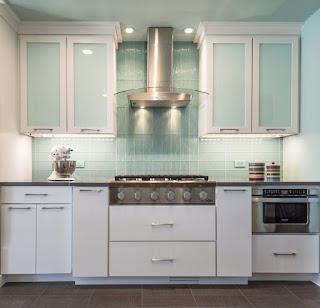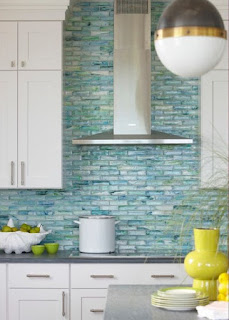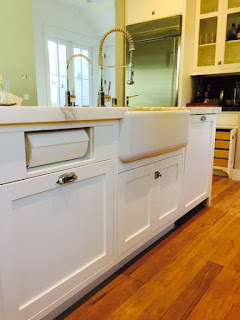Details That Count: 17 Designer Tips for a Great Kitchen
By Barbra Bright
Get ideas for camouflaging your outlets, adding tasklighting
and avoiding common kitchen annoyances
Great design is all about
the details — especially those that, when done right, you don’t notice at all.
As a kitchen designer, I have a number of special techniques to create gorgeous
kitchens that function beautifully. Here are 17 of my best kitchen design
secrets.
All About Outlets
1. Color-coordinate the outlets. Local building codes often state that there must be an electrical outlet every 4 feet in the kitchen. White outlets are seemingly the color of choice for electricians — and therein lies the bane of my design existence. With their glaring contrast, white outlets in a nonwhite backsplash detract from the beauty of the tile. Fortunately, you can avoid this dilemma by coordinating your outlets and wall plates with the color of your backsplash tile, as shown in this photo.
1. Color-coordinate the outlets. Local building codes often state that there must be an electrical outlet every 4 feet in the kitchen. White outlets are seemingly the color of choice for electricians — and therein lies the bane of my design existence. With their glaring contrast, white outlets in a nonwhite backsplash detract from the beauty of the tile. Fortunately, you can avoid this dilemma by coordinating your outlets and wall plates with the color of your backsplash tile, as shown in this photo.
2. Install undercabinet
plug molding. One option for a clutter-free backsplash is to install
plug molding beneath the wall cabinets.
3. Mix outlet styles. I always ask clients if a toaster or a coffee maker will live on their counter. If so, I add a wall outlet behind that appliance since it will always be plugged in. Otherwise, the electrical cord will be visible as it dangles from the plug molding above. Remember to combine a mixture of outlets and plug molding into your design.
4. Go for pop-up outlets. Another
option for an outlet-free backsplash is a pop-up outlet that disappears into the countertop. These are
especially useful in places where there are no wall cabinets to hide a plug
molding strip.
5. Turn the outlet sideways. If wall outlets are
your desired solution, install them sideways and closer to the counter for a
less obtrusive profile than the common vertical orientation.
6. Create a charging
station. A plethora of devices need charging these days. Create a
docking drawer with a hidden charge station so that you can keep your
smartphones and iPads out of sight.
Lighting Secrets for Style and Function
7. Provide task lighting. The primary purpose of undercabinet lighting is to illuminate the countertop, which in turn makes food preparation easier on the eyes. That’s why it’s known as task lighting. Always install the task light toward the front of the cabinet, not toward the back. If the light is stationed closer to the back wall, it primarily highlights the backsplash tile and not the counter, defeating the purpose of the light.
7. Provide task lighting. The primary purpose of undercabinet lighting is to illuminate the countertop, which in turn makes food preparation easier on the eyes. That’s why it’s known as task lighting. Always install the task light toward the front of the cabinet, not toward the back. If the light is stationed closer to the back wall, it primarily highlights the backsplash tile and not the counter, defeating the purpose of the light.
8. Make cabinets glow. In
the past, lighting the interior of a wall cabinet meant that each shelf had to
be glass. The light source came from the top of the cabinet and needed to
penetrate the shelves to illuminate those below. The farther away from the
light source, the dimmer the shelf.
But times and lighting have changed, and these days, I prefer to install an LED lighting strip on both sides of the cabinet. That way, each shelf can glow, as shown in this photo. Hide the LED strip behind the cabinet’s face frame. If it’s a frameless cabinet, embed the strip in a prepared groove in the cabinet’s side wall.
Appliance Tricks
9. Hide the dishwasher with paneling. Whether or not you are paneling the refrigerator, consider paneling the dishwasher for a clean, harmonious look, uninterrupted by a stainless steel appliance next to the sink. In this photo, the dishwasher lies to the left of the sink.
10. Conceal the
microwave. Microwaves are still an integral part of most kitchens for
reheating beverages and leftovers. Most clients prefer them out of sight rather
than occupying valuable counter space. One option is to keep them hidden in a
wall cabinet with a lift-up door, as shown in this photo.
Hood Smarts
11. Don’t crowd the hood. When using a chimney hood, always leave at least 2 to 3 inches between the hood and the wall cabinets to the left and right. Visually, the hood will not look cramped, and the sides of the cabinets will stay cleaner longer.
11. Don’t crowd the hood. When using a chimney hood, always leave at least 2 to 3 inches between the hood and the wall cabinets to the left and right. Visually, the hood will not look cramped, and the sides of the cabinets will stay cleaner longer.
12. Rethink glass
cabinetry next to a hood. Glass cabinets create a
lovely focal point when placed next to a hood, but are they practical? Unless
you’re prepared to constantly clean the glass of the grease and grime emanating
from cooking, it’s best to install them elsewhere.
Avoiding Annoyances
13. Define the zones. Think in terms of prepping and cleanup zones when planning your kitchen. Do you really want your cleanup sink to be in the island filled with dirty dishes? Put the prep sink on the island and tuck the cleanup sink out of the way.
13. Define the zones. Think in terms of prepping and cleanup zones when planning your kitchen. Do you really want your cleanup sink to be in the island filled with dirty dishes? Put the prep sink on the island and tuck the cleanup sink out of the way.
14. Maximize prep space
on an island. I love symmetry, and for years, I would center the sink in the
island. But unless the island was 9 feet long, the prep area on both sides of
the sink was limited. These days, I hold the sink to one side of the island to
allow for maximum prep space.
Another consideration when placing a sink in an island is the height of the faucet. The taller the faucet, the more of a focal point it becomes.
Another consideration when placing a sink in an island is the height of the faucet. The taller the faucet, the more of a focal point it becomes.
15. Countersink the
screw. The cabinet next to a Lazy Susan cabinet with a bifold door
often shows scratches over time. That’s because the head of the screw holding
the Lazy Susan’s cabinet hardware in place protrudes and scrapes across the
adjacent cabinet when the door is being closed.
Here’s an easy fix: Just
have your contractor countersink the screw so that the head of the screw is
flush with the wood and no longer protrudes.
16. Account for lid storage. Having to store pot lids
can be a nightmare. There are many ways to solve this problem, but my favorite
is to create a divider in a pullout drawer, as shown in this photo.
17. Clear the decks. Don’t
forget to add accessories like a soap dispenser and an air switch to keep
clutter off the counters and backsplash.
Getting ready to remodel? Cabinet-S-Top can assist you in the design details to create a great kitchen. Located at 1977 Medina Road, Medina, OH 44256 ~ 330.239.3630 ~ www.cabinet-s-top.com
Getting ready to remodel? Cabinet-S-Top can assist you in the design details to create a great kitchen. Located at 1977 Medina Road, Medina, OH 44256 ~ 330.239.3630 ~ www.cabinet-s-top.com



















Comments
Post a Comment